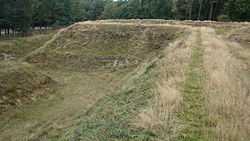Sconce (fortification)


A sconce is a small protective fortification, such as an earthwork often placed on a mound as a defensive work for artillery.[1] It was used primarily in Northern Europe from the late Middle Ages until the 19th century. This type of fortification was common during the English Civil War, and the remains of one such structure can be see on Fort Royal Hill in Worcester, England.[2] During the Eighty Years' War for Dutch independence, sconces were often used to defend strategic places, but were used also during sieges and in circumvallations. Several more or less intact sconces remain in the Netherlands.
Etymology
| Look up sconce in Wiktionary, the free dictionary. |
The etymology of sconce is from the Latin absconsus, via the French esconce, is a word of many meanings, mostly signifying a covering or protection, or, by extension, that which is covered or protected.[3] The word is closely related to the medieval Dutch schans and the German word Schanze, as used for example in the name of Hitler's military headquarters, the Wolfsschanze.[4]
See also
References
- ↑ Images of England: Sconce
- ↑ Fort Royal, Worcester
- ↑
 This article incorporates text from a publication now in the public domain: Chisholm, Hugh, ed. (1911). "Sconce". Encyclopædia Britannica 24 (11th ed.). Cambridge University Press. p. 407
This article incorporates text from a publication now in the public domain: Chisholm, Hugh, ed. (1911). "Sconce". Encyclopædia Britannica 24 (11th ed.). Cambridge University Press. p. 407 - ↑ ensconce The Lexiteria & alphaDictionary
| Wikimedia Commons has media related to Sconce (fortification). |